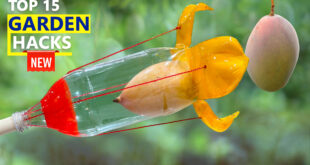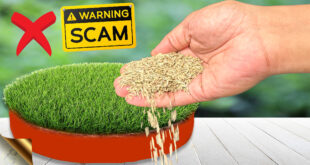In Today’s post, let’s look into 10 really smart and scientific tips and tricks to successfully grow healthy tomato plants to yield tons of tomatoes. Plus one very useful scientifically proven bonus tomato hack in the end which can make all that difference.
Tomatoes are usually the first veggie many newbie gardeners grow from seeds. To Improve your success and achieve a healthy harvest, let’s learn these 10 tips on growing tomatoes starting from the seedling tips till the harvesting stage. These tips apply to any variety of tomato you grow, whether determinate or indeterminate types.
- SEED PLANTING TIPS: You can easily grow tomatoes from seeds or tomatoes from tomatoes. You can plants seeds in small containers or seed trays. We will not go into these details in this episode. We will only tell you the tricks to be applied at this stage. Once they germinate and grow into little ones, you can choose the best ones and transplant them to small 4 to 6 inch pots and discard the weaker seedlings – that’s called thinning of seedlings. The first Trick to apply at this stage, that is the early growth stage, during or after the first transplant. The main idea is to strengthen the root system of this young plant. A strong root system will make the plant healthier, disease resistant and is responsible for the quality and quantity of harvest. At this stage, you must add a source of phosphorous to help the plant produce stronger roots – the best one is the organic rock phosphate – about half a teaspoon per seedling. If you do not have this, you can also add steamed bone meal powder.
- The Final Transplant: Here again you need to apply two tricks. When the plant reaches to about 8 to 10 inches tall you can transplant this into the final spot whether growing in ground or in containers. On ground, maintain atleast 1 to 2 feet spacing between plants. If you are transplanting to containers, choose large containers, like at least 15 inches in size. The larger, the better. Well, the two tricks to apply here: One is you add 1 to 2 tablespoons of Organic rock phosphate into the hole and place the roots in direct contact with this. You can also use finely powdered steamed bone meal. This source of phosphorous is sufficient for the entire growth cycle of the plant. The second trick to apply is: Planting as Deep as possible. You can see the tomato stem has hundreds of tiny hair and these when come in contact with soil forms stronger roots. So, you plant it as deep as possible by removing the bottom leaves. These two tricks will form a robust root system which in turn will produce a high yielding, disease resistant tomato plant.
- STAKING: Staking or supporting the tomato plants is a very crucial step to get a healthier plant and a good harvest. There are many ways to stake tomatoes – like using good quality tomato cages. This type of cage or trellis is not recommended, as its not durable. I will show you two easiest methods to support tomato plants. One is making your own trellis using some wooden sticks or even bamboo sticks. Just firmly tie three sticks on top and insert the base into the soil. The second method is using a string support. One string per plant. But you have to anchor the string to the soil by using some method, like a thick iron wire or these type of rods and loops which are easily available online. Insert this to the soil and tie a string, one end at the bottom and the other end to another support, something like this overhead crossbar. Do not twist the string tightly onto the stem. For this you can use these cheap plastic plant clips – which are completely safe and useful to hold the plant to the string without compressing the stem.
Lastly, the least you can do is just insert wooden sticks around the plant to support the growing plant. This is because the tomato stem is tender and if not supported can break easily or it can take awkward bends and the whole system may look awkward.
- PRUNING & SUCKERS: This is another important trick to perform for great results and to prevent disease. Tomato suckers or side shoots are the growths that appear in the junction between the stem and a branch of a tomato plant. Removing these suckers is recommended, simply to divert the nutrients for the growth of main stem and its main branches. Your plant may have more fruit if you let the suckers grow, but the tomatoes will be smaller in size.
Then, generally, pruning of the lower branches is also recommended, especially for the indeterminate variety of tomato plants. But I recommend this even for determinate varieties. The main reason is to maintain good air circulation which can prevents many diseases. Another tip here is: As the plant grows taller, keep removing the older leaves or older branches from the bottom zones. - SUNLIGHT: Tomatoes love to be in full direct sunlight for at least 6-8 hours of continuous sun. So, whether you are growing on ground or containers, you have to choose a location which receives maximum amount of sunlight.
- WATERING: Tomatoes love to be in moist soil right from the seedling stage. As a general rule, You may have to water them daily and depending on the temperature you may have to water them even twice. Installing drip irrigation system helps a lot. You can also mulch the top soil with dried leaves, dried grass clippings, straw or even mulching sheets. This not only prevents water evaporation but also prevents weed growth.
Well, When you water once daily, water thoroughly and deeply so that the deeper roots are well hydrated. Inadequate watering can result in poor absorption or uptake and supply of nutrients to different parts of the plant. Blossom End Rot problem seen in tomatoes is due to calcium deficiency mainly due to this transportation issue and may not be due to soil deficient of calcium. So proper watering is very important to prevent the blossom end rot issue which is an irreversible process. - SOIL AND FERTILIZERS: You can use your usual well draining loose potting soil for container gardening with at least 30 percent compost in it and 30 percent garden soil and another 30 percent cocopeat plus some 10 percent other stuff like bonemeal, neem powder, perlite, vermiculite and so on. We have discussed this in one of our old video titled universal potting mix. You can check that from HERE. Well, we have already discussed about the role of Organic Rock Phosphate and how important it is for a healthy root system and fruiting. You can add a handful of compost like decomposed cowdung or vermicompost to the top soil once in a week or 15 days. Then optionally you can also add seaweed zyme granules once in a while or foliar feed with liquid seaweed extract. You can also foliar spray Epsom salt like 1 teaspoon per litre of water, once in 15 days. And If you think, your soil is calcium deficient and you want to make yourself 100% sure of preventing Blossom End Rot disease, then you can add an additional source of calcium into the soil. You can check my video on the Various sources of calcium and how to make free soluble calcium to treat acute calcium deficiency.
- POLLINATORS: Encourage beneficial insects and pollinators like butterflies and honey bees to encourage pollination and fruit formation. Do not use chemical pesticides, they can drive away or even kill these useful pollinator insects. But, you may have to protect your fruits from birds pecking on the fruits after the fruit formation.
- PESTICIDES: Common tomato pests include Aphids, whiteflies, caterpillars, slugs and snails, tomato hornworms, cut worms and so on. Tomato yellow leaf curl virus needs a special mention. As I said earlier, a strong disease resistant plant will never have this type of disease. This virus curl has no treatment like any other virus in the world. Just discard and dispose off the plant so that it doesn’t affect the other plants close by. The last bonus tip is actually an immunity booster to tomato plant. Will discuss it shortly.
Prevention is better than cure. To avoid any pest attack, weekly once spraying of our broad spectrum Neem Oil is the best solution. Say No to Chemicals and Insecticides. For seedling stage, spray 5ml neem oil per litre of water and for mature plants 10 ml of Neem oil per litre of water. You can optionally add half a teaspoon of baking soda into this spray. Always do a patch test on a leaf to check the potency of you preparation, before spraying on the entire plant. - COMPANION PLANTING: Planting some companions close to tomatoes will help prevent pests. You can plant basil, parsley, cilantro, garlic, marigolds and many others.
- BONUS TIP: Many researches have shown that Tomatoes use a hormone similar to salicylic acid to trigger a response called ‘systemic acquired resistance’ or SAR. This response helps a tomato plant fight off bacteria, fungi and other diseases. Aspirin is acetyl salicylic acid. Spraying aspiring from the seedling stage onwards makes your tomato plant immune to many diseases. You can drop half a tablet of Aspirin 350 mg dispersible tablet into 1 litre of water and spray on the plant, once in a while like once in 15 days or so.
Happy Gardening!
 GKVKs – Gardening Tips and Store Gardening Tips and Store
GKVKs – Gardening Tips and Store Gardening Tips and Store



